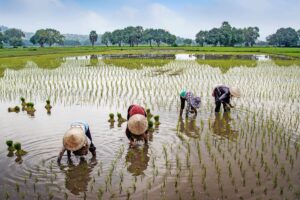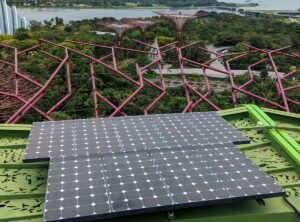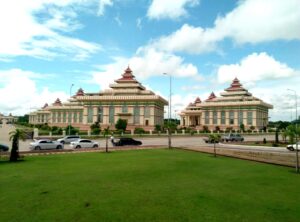Summary
The proposed 180km Funan Techo Canal project in Cambodia will deliver significant transboundary impacts to water availability and agricultural production in Vietnam’s Mekong Delta, with acute impacts to An Giang and Kien Giang provinces. The project will convert many existing narrow, low-levee canals in Cambodia which currently do not alter wet season flooding pathways into wider, high-levee canals which will reduce wet season flooding in both Cambodia and Vietnam. Wet season flooding provides positive benefits to both Cambodia and Vietnam by driving agricultural production and creating large, natural wetlands that provide economic security to millions of people and robust biodiverse habitats. Floodplain alterations will cause wet season flooding to attack the canal’s high levees and result in higher than anticipated construction and maintenance costs across the life cycle of the canal.
Currently the only document outlining the project’s functions, impacts, and blueprints is the August 8, 2023 CNMC notification document to the MRC. In the notification document, the project is incorrectly designated as a “tributary” project even though the project connects to two Mekong mainstream channels. The incorrect tributary designation allows the Cambodian government to avoid 1995 Mekong Agreement prior consultation protocols and hastily commence construction without subjecting the project to a technical review and other processes which could improve the design and operation of the canal.
Further, after the August 2023 CNMC notification, the official narrative on the canal’s functions has changed to include irrigation benefits which are not discussed in the CNMC notification document and could have additional impacts to the water availability in the delta. The changing narrative on the canal’s functions is another valid cause for concern.
Recommendation
Given the severe potential transboundary impacts, evidence of changing functional descriptions over time, incorrect designation of the project, and an overall lack of project documentation, concerned parties should advocate for the CNMC to correctly designate the canal as a mainstream project. This will initiate MRC prior consultation processes which provide a pathway and sufficient time to comprehensively assess canals impacts, propose mitigation changes, and explore alternatives. Failing to initiate the MRC consultation processes will result in an erosion of the MRC’s ability to carry out its mandate set forward in the 1995 Mekong Agreement and set precedent for other MRC member countries to ignore their international treaty responsibilities when developing future projects.
Project Overview
The 180km Funan Techo Canal project was approved by Cambodia’s Council of Ministers in 2023 and a notification document was sent from the Cambodia National Mekong Committee (CNMC) to the Mekong River Commission (MRC) on August 8, 2023, two weeks prior to PM Hun Sen’s resignation. The $1.7 billion Belt and Road project will be built as a build-operate-transfer (BOT) project, likely by Chinese state-owned enterprise China Bridge and Road Corporation (CRBC) with construction slated to begin in 2024 and end in 2027. Recent media reports suggest the Chinese BOT owner will have a lease on the project for 40-50 years.
The canal would permit barges to move goods from Phnom Penh to a new port facility at Kep to be loaded onto ocean-bound ships. Currently, ocean-bound shipping from Phnom Penh must pass through Vietnam’s Mekong Delta to ports near Ho Chi Minh City. The CNMC notification document states the project will promote “the development of Cambodia’s integrated transport system, ensuring the safety of the national water transport network, reducing social logistics costs, driving Cambodia’s economic and social development to achieve new breakthroughs and promoting the coordinated development of regional economy.”
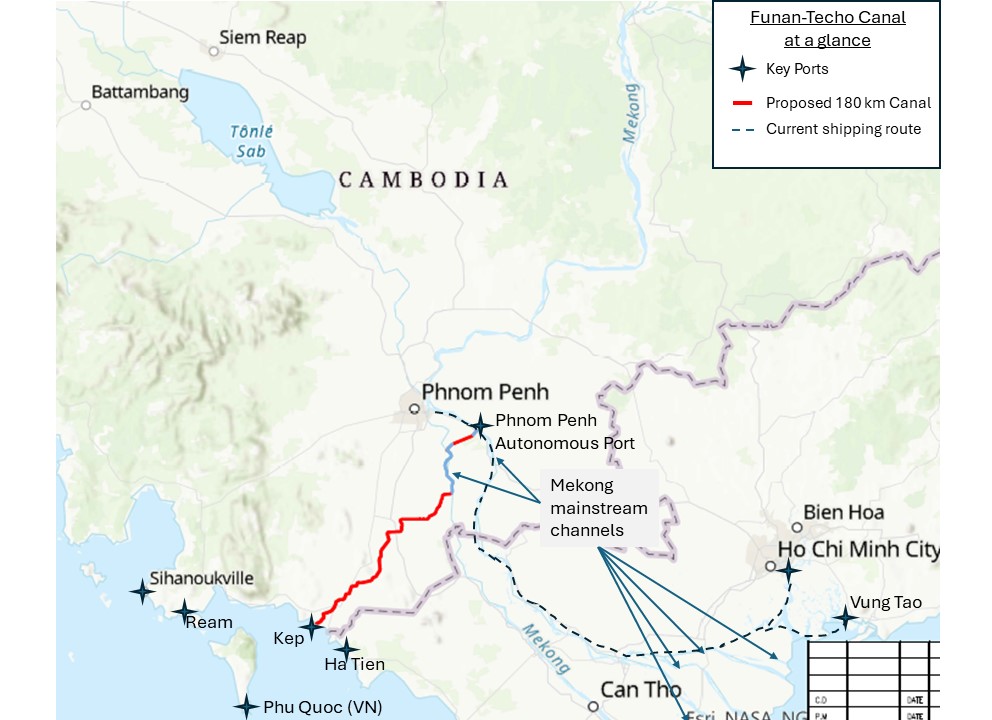
Figure A: This is a modified version of a map provided in the MRC notification document.
Incorrect Notification to the MRC
The MRC is not yet involved at an appropriate level because the CNMC has designated the project incorrectly in the notification document as a “tributary” project even though the canal clearly connects to two branches or channels of the Mekong mainstream (See figure A): the channel commonly referred to as the Mekong mainstream and the Bassac Channel. These are channels of the mainstream because they both carry the mainstream’s water. By definition, a tributary cannot carry mainstream water. Yet, even former Prime Minister Hun Sen has publicly stated that the canal does not connect to the Mekong Mainstream. Regardless of how the Bassac Channel is defined, canal blueprints submitted by the CNMC prove this claim to be inaccurate.
Concerned parties should advocate for the CNMC to change the project designation from “tributary” to “mainstream” as a means to initiate mandated prior consultation processes for mainstream projects.
Article 5 of the Mekong Agreement requires prior consultation for any project that connects to the Mekong mainstream and alters mainstream flow. It is still possible for the CNMC to properly designate the canal as a mainstream project as required by the 1995 Mekong Agreement. This would initiate the MRC Procedures for Notification, Prior Consultation, and Agreement (PNPCA), initiating the prior consultation process which includes regional stakeholder forums in all MRC countries and requires submission of all related project documents to the MRC Secretariat and the National Mekong Committees of Vietnam, Thailand, and Laos. The prior consultation process would also include an expert-led technical review process that will improve the environmental mitigation outcomes of the project design.
There is precedent for pursuing a change to the notification document. In 2013, the Lao PDR National Mekong Committee incorrectly designated the Don Sahong Hydropower Project as a “tributary” dam even though it was clearly sited on a channel of the Mekong mainstream. Diplomatic pressure from the CNMC and development partners such as the United States, Australia, and Japan effectively convinced the Lao PDR National Mekong Committee to change the project designation from “tributary” to “mainstream”. The change initiated the prior consultation process which provided time to give full assessment of the project’s impacts and added critically important fisheries mitigation infrastructure that currently facilitates fish migration around the dam site.
Potential Inter-basin Diversion
The notification document states that the project will have “no significant impact on (and thus no negative implication to) the Mekong River system’s daily flow and annual flow volumes.” The document refers to a navigation lock system (See Figure B) that will prevent water from leaving the Mekong mainstream and flowing into the Bassac channel. The lock system is also designed to prevent water from flowing from the Mekong Basin into the Gulf of Thailand. If properly managed and operated, the lock system can indeed prevent significant outflow from the Mekong mainstream channels, and as such river levels downstream in Vietnam could be minimally affected.
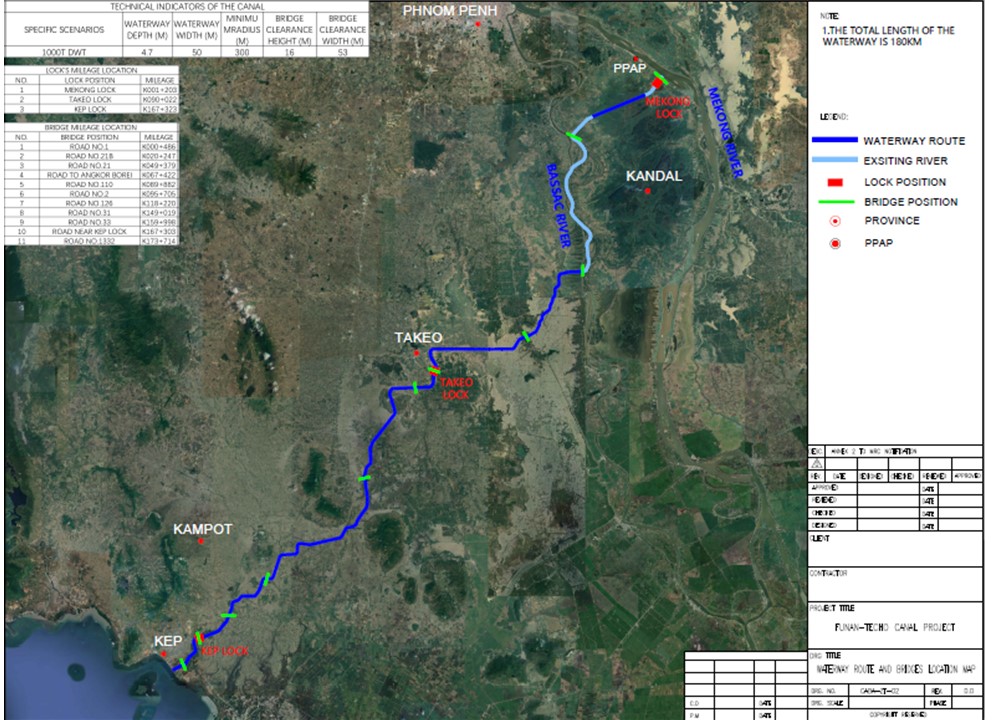
Figure B: Canal blueprint submitted as part of the MRC notification document.
However, by including the mitigation efforts of navigation locks into the canal’s current design does not create a pathway for the CNMC to circumvent rules set forth in the 1995 Mekong Agreement. The canal has the potential to divert water from the Mekong Basin to coastal estuaries in Cambodia outside of the Mekong Basin (and into the Gulf of Thailand). This qualifies as an inter-basin diversion. Article 5 of the 1995 Mekong Agreement states all inter-basin diversion projects are subject to MRC prior consultation.
Concerned parties should request more information on the design, maintenance, and operations of the navigation lock system. Further, the government of Cambodia should provide real-time reporting on lock operations throughout the life cycle of the canal project in order to ensure there is no significant transfer of water from the Mekong mainstream to the Bassac Channel or from the Mekong Basin to the Gulf of Thailand.
Potential Dry Season Intra-basin Use for Irrigation
In a social media post on April 9, 2024, former Prime Minister Hun Sen wrote in reference to the Funan Techo Canal that “This vital infrastructure facilitates agricultural activities by providing water for crop cultivation…” and the irrigation function of the canal has been mentioned in other media articles written by Cambodian authors. The canal’s irrigation benefits were also discussed in an English language video interview by Deputy Prime Minister Sun Chanthol on May 1, 2024. However, the CNMC notification document does not mention irrigation nor agricultural benefits in the section entitled “Positive Impacts” where the canal’s other functions are outlined. If secondary and tertiary canals for the facilitation of irrigation and agricultural purposes are to be built as part of the canal’s design, these designs are not provided in the project blueprints submitted as attachments to the CNCM notification document. If the canal does have an irrigation use, then it will at times use much more than the 3 m3/s of Mekong mainstream and Bassac Channel (also mainstream) flow outlined in the CNMC notification document. As such, Vietnam’s downstream concerns of loss of Mekong flow to Vietnam’s Mekong Delta are entirely justified.
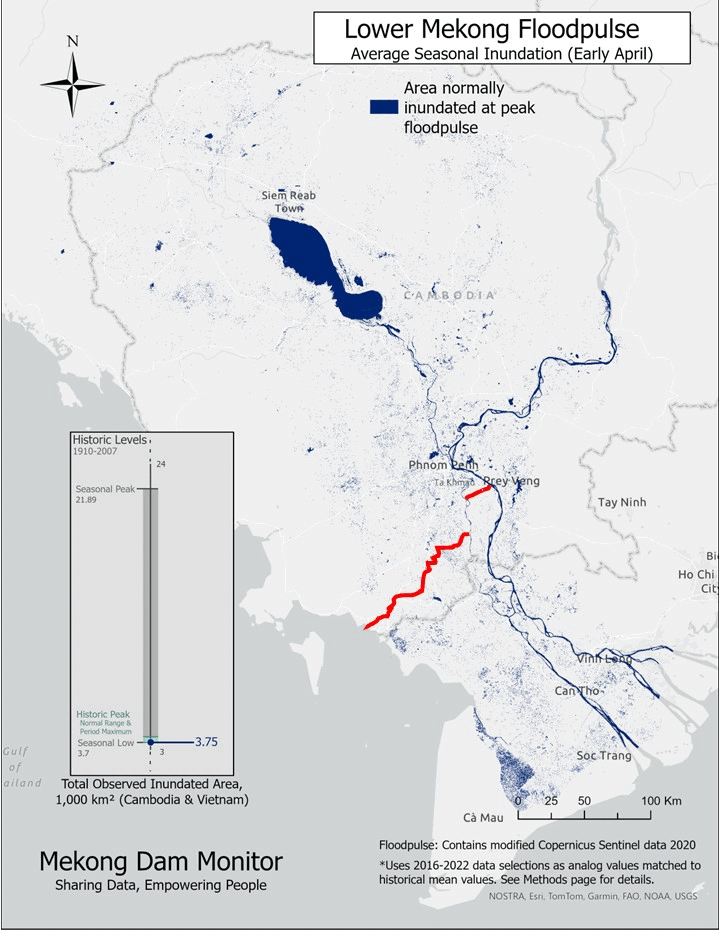
Figure C: Pathway of the Funan Techo Canal juxtaposed on top of an animation of the a normal Mekong Floodpulse (derived from 2018 Sentinel-1 SAR imagery).
The canal passes through an active floodplain (see Figure C) which is flooded for several months during the wet season, so it is logical to assume that water used for irrigation purposes will primarily be extracted from the Mekong during the dry season. Article 5 of the 1995 Mekong Agreement states dry season utilization of mainstream flow for intra-basin use (use within the Mekong Basin) is subject to MRC prior consultation and also an agreement between MRC member countries, a diplomatic exercise never before undertaken by the MRC.
If the canal is intended for dry season irrigation use, the CNMC should update its notification document to clearly state this function and request prior consultation in accordance to Article 5 of the 1995 Mekong Agreement. Until this happens, concerned parties should seek clarity on the irrigation function of the canal and request an updated notification document.
Transboundary Floodplain Impacts
Geospatial analysis suggests the canal will widen many existing low levee canals and cut across floodplains and rural lands which currently do not have canals or waterways (Figure D). The existing low levees permit the natural flow of high floods during the wet season. It can be inferred from the notification document that in order to prevent the two-lane canal and related navigation locks and water gates from flood damage, high levees will need to be constructed.

Figure D: This map shows how the Funan Techo Canal (red) will convert and connect existing, smaller canals into a larger, wider canal structure and the pathway of the canal structure through the floodplain (Map: Stimson Center).
The notification document does not discuss the specific height of these levees, so concerned parties should seek clarity on the height, length, and location of the canal’s levees. High levees will alter and bisect a large portion of the transboundary Mekong floodplain, and this will prevent wet season floods from passing through the floodplain into Vietnam (See Figure E). Seasonal flooding that approaches the levees from the upstream will then be unable to pass and instead flow sideways along the levee, perpendicularly pressuring the constructed levee. This creates the possibility of structural damage or failure, particularly during intense precipitation events. As climate change intensifies, so will the intensity of precipitation events. High levees bifurcating the floodplains could also cause flooding to back up into upstream areas which typically do not flood, likely including parts of Takeo City and possibly peri-urban areas of southern Phnom Penh and the site of the new Techo International Airport (yellow arrows in Figure E). Flood modelling can determine the pathway and extent of new flooding caused by the canal’s levee system under both normal seasonal flooding scenarios and extreme precipitation events of varying magnitudes. Flood modelling is necessary to ensure the project’s long-term benefits as well as understanding the project’s impacts downstream. The costs of levee maintenance and flood damage mitigation introduced by the canal are not discussed in the project notification document.
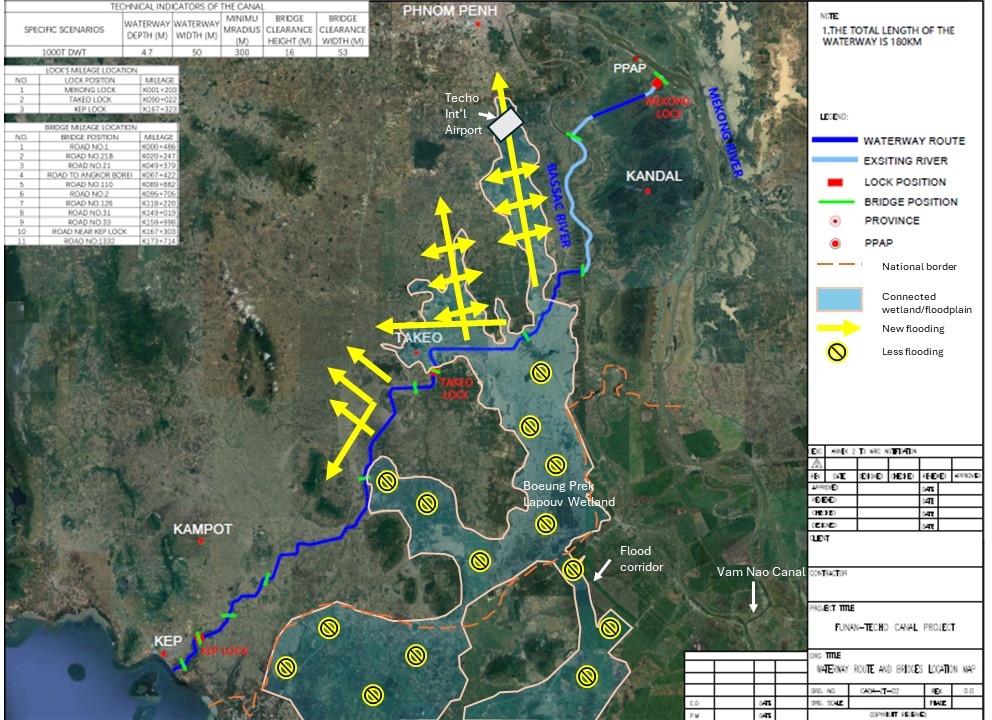
Figure E: This map is a modified version of a map provided in the MRC notification document.
Further, more than 1300 square kilometers of transboundary floodplain could become significantly drier as a result of the canal’s inability to pass seasonal floods through its high-levee system (yellow-black circles in Figure E). This impacted area spans significant parts of southern Cambodia and Vietnam’s Mekong Delta. In Cambodia, the impacted area includes the Boueng Prek Lapouv wetland which, according to an IUCN report, “represents one of the largest remnants of seasonally-inundated grasslands in the Lower Mekong Region, at over 8,300 hectares in size. It is one of 40 globally Important Bird Areas (IBAs) identified as key sites for conservation in Cambodia and one of three sarus crane (Grus antigone) Conservation Areas.” The Cambodian government has officially designated Boeung Prek Lapouv as a Protected Landscape Area and has submitted it for international Ramsar designation. International conservation organizations such as IUCN, Wildlife Conservation Society, and Wildfowl and Wetlands Trust are engaged in collaborative activities with Cambodian government agencies supported by development aid.
In Vietnam, a portion of the Kenh Vinh Te Canal in An Giang was lowered in the last decade to permit seasonal flooding to flow into and irrigate much of the western portion of Vietnam’s Mekong Delta. Seasonal flooding also passes naturally over the Kenh Vinh Te Canal in Kien Giang Province to provide natural irrigation there. This area is labelled as “Flood corridor” in Figure E. Without alterations to the canal’s design or proper mitigation, this large area of the Mekong Delta along with a signification portion of Cambodia’s floodplain along its border will be severely impacted. The reduction in natural flooding and increased dryness will lead to loss of industrial scale agricultural production. The reduction of seasonal flooding and its impact on industrial scale agriculture can be determined by studies. The Stimson Center Southeast Asia Program assesses that the most significant environmental impacts of the canal will be delivered via alteration of the transboundary floodplain between Cambodia and Vietnam. The CNMC notification document mentions nothing of these floodplain impacts.
Concerned parties should seek clarity on transboundary floodplain impacts and request an update to the CNCM notification document. If the specific height, location, and design of the canal’s levees are known, then it will be possible to model and determine the impacts introduced to the transboundary floodplain.
Existing Alternatives
All infrastructure projects should consider the costs and benefits of alternative projects prior to construction. Alternative canal pathways could entirely avoid alterations to the transboundary floodplain and therefore avoid reductions to industrial scale agriculture in Vietnam and negative impacts to the Boeung Prek Lapouv wetland.Since the canal’s limited depth cannot facilitate the passage of large container shipping, perhaps it is more economically prudent for goods which utilize the canal via 1,000-ton ships to utilize other means of linear transportation such as highways or railway. In 2023, a $2 billion Belt and Road expressway from Phnom Penh to Sihanoukville’s deep water port was completed. While highway transport is more expensive than river transportation, full utilization of the highway as an alternative to the canal would avoid all transboundary impacts to Vietnam and could avoid the need for a costly deep-water port at Kep (which would come with its own environmental and social impacts). An existing railway line from Phnom Penh to the Sihanoukville deep water port can also be improved, likely at much lower cost than the life cycle cost of the canal, particularly when considering unanticipated expenses of maintaining and rebuilding the canal’s levees after flood damage. Concerned parties should suggest these alternatives to avoid the transboundary impacts and the high unanticipated costs of the canal.
Conclusion
While the Cambodian government has every right to develop infrastructure within its sovereign territory, as a signatory to the 1995 Mekong Agreement its government needs to act in accordance to international law when it comes to projects within the Mekong Basin. Incorrect interpretation of the Mekong Agreement opens the door for other signatory countries to skirt the rules on future upstream projects which could deliver profound transboundary impacts to Cambodia, such as Thailand’s Khong-Chi-Mun massive water diversion project. Over the past decade Cambodia has been among the most vigilant countries in terms of holding other MRC member countries accountable to the 1995 Mekong Agreement. By initiating the prior consultation process, Cambodia will maintain its legacy as a champion of the Mekong Agreement and the MRC’s regional consultations and expert technical review will allow specific concerns to be addressed and common ground identified.
Header image: DSC01988, Panama Canal, Colon, Panama


